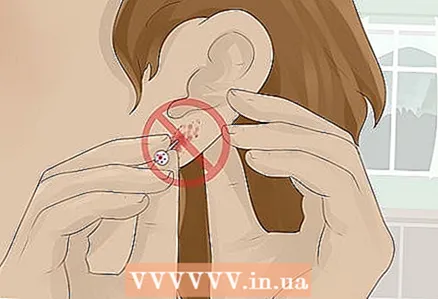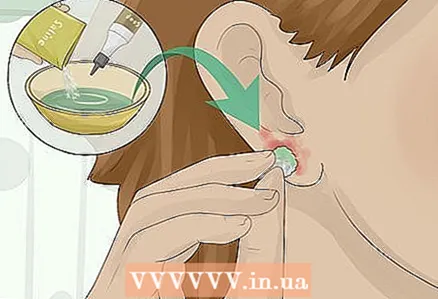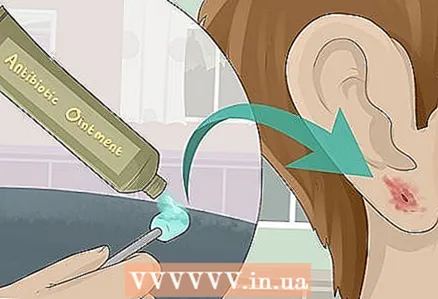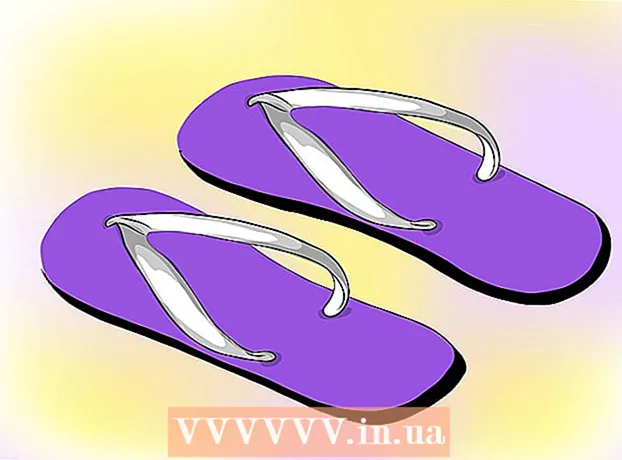Author:
Joan Hall
Date Of Creation:
6 July 2021
Update Date:
1 July 2024

Content
- Steps
- Method 1 of 3: How to Treat an Infected Puncture at Home
- Method 2 of 3: When to Seek Medical Help
- Method 3 of 3: How to prevent re-infection
- Warnings
Ear piercing infection is quite common, especially if the piercing is new. Most infections clear up in 1 to 2 weeks, provided you clean the puncture site twice a day. Wash the infected area with a cotton swab or cotton swab dipped in saline or antibacterial soap, then pat dry with a disposable paper towel. Do not use alcohol or peroxide, as these substances will only slow down the healing process. Make an appointment with your doctor if the infection spreads to nearby tissues, if there is no improvement within two days, or if your temperature rises. Wash your hands before touching the puncture, stop swimming until the puncture heals completely, and disinfect your cell phone to prevent re-infection.
Steps
Method 1 of 3: How to Treat an Infected Puncture at Home
 1 Wash your hands before touching the piercing. Wash your hands thoroughly before touching a piercing, especially if it is recent or infected. Wash your hands with warm water and antibacterial soap. Try to touch the earrings as little as possible and only touch them to clean them.
1 Wash your hands before touching the piercing. Wash your hands thoroughly before touching a piercing, especially if it is recent or infected. Wash your hands with warm water and antibacterial soap. Try to touch the earrings as little as possible and only touch them to clean them.  2 Do not remove new piercings. If your piercing is new, do not remove it for at least six weeks, even if the piercing is infected. Although the piercing in the earlobe needs to be rotated, stop doing it if the infection develops within the first two weeks after the piercing.
2 Do not remove new piercings. If your piercing is new, do not remove it for at least six weeks, even if the piercing is infected. Although the piercing in the earlobe needs to be rotated, stop doing it if the infection develops within the first two weeks after the piercing. - If the piercing is permanent or installed more than six months ago, remove it while you fight the infection.
 3 Treat the piercing with a cotton ball soaked in saline or soap. Dip a cotton ball or cotton swab in saline or mild antibacterial soap. Blot the infected area with a cotton swab or ball, and then wipe it dry with a disposable paper towel.
3 Treat the piercing with a cotton ball soaked in saline or soap. Dip a cotton ball or cotton swab in saline or mild antibacterial soap. Blot the infected area with a cotton swab or ball, and then wipe it dry with a disposable paper towel. - If saline is available from the salon where you got your ear pierced, use it to clean your ears. Buy a ready-made product or make your own saline solution by diluting 2 teaspoons (10 g) of salt in a liter of warm water.
- If you decide to use soap, make sure it is unflavored and does not contain alcohol.
- Treat an infected puncture twice a day. Earrings wet with saline or soap can be rotated.
 4 Apply an antibiotic ointment. After you've cleaned and dried your piercing, you can apply an antibacterial ointment to speed up the healing process. Squeeze some ointment onto a cotton swab and then apply a thin layer of ointment to the infection site.
4 Apply an antibiotic ointment. After you've cleaned and dried your piercing, you can apply an antibacterial ointment to speed up the healing process. Squeeze some ointment onto a cotton swab and then apply a thin layer of ointment to the infection site. - Do not use ointment if ichor or other liquid comes out from the infected area.
 5 Do not use rubbing alcohol or hydrogen peroxide. Medical grade (isopropyl) alcohol and hydrogen peroxide dry out the infection and kill the cells needed for healing. The destruction of white blood cells near the site of infection can further exacerbate the infection. Do not apply alcohol or hydrogen peroxide to the infection, and make sure the cleansers you use are alcohol-free.
5 Do not use rubbing alcohol or hydrogen peroxide. Medical grade (isopropyl) alcohol and hydrogen peroxide dry out the infection and kill the cells needed for healing. The destruction of white blood cells near the site of infection can further exacerbate the infection. Do not apply alcohol or hydrogen peroxide to the infection, and make sure the cleansers you use are alcohol-free.
Method 2 of 3: When to Seek Medical Help
 1 Make an appointment with your doctor if the infection does not improve after 2 days. Treat the infected puncture twice a day. After two days, signs of improvement should appear, such as reduced redness and swelling. If the condition of the infection does not change in any way or even worsens, make an appointment with a doctor or contact an emergency room.
1 Make an appointment with your doctor if the infection does not improve after 2 days. Treat the infected puncture twice a day. After two days, signs of improvement should appear, such as reduced redness and swelling. If the condition of the infection does not change in any way or even worsens, make an appointment with a doctor or contact an emergency room.  2 See your doctor if the infection spreads to surrounding tissues or if you develop a fever. Monitor the infection closely on the first day. See your doctor if the infection starts to spread beyond the puncture or if you have a fever. This could be a sign of a more serious infection that may require antibiotics to treat.
2 See your doctor if the infection spreads to surrounding tissues or if you develop a fever. Monitor the infection closely on the first day. See your doctor if the infection starts to spread beyond the puncture or if you have a fever. This could be a sign of a more serious infection that may require antibiotics to treat.  3 See your doctor for an examination of an infected cartilage puncture. Take extra care when dealing with an infected cartilage piercing or piercing in the upper ear. It is better to play it safe and see a doctor so that he can examine the site of infection as soon as possible. A cartilage puncture infection is much more likely to worsen, and it can lead to long-term deformities of the pinna, such as bumps on the cartilage.
3 See your doctor for an examination of an infected cartilage puncture. Take extra care when dealing with an infected cartilage piercing or piercing in the upper ear. It is better to play it safe and see a doctor so that he can examine the site of infection as soon as possible. A cartilage puncture infection is much more likely to worsen, and it can lead to long-term deformities of the pinna, such as bumps on the cartilage.  4 Talk to your doctor about taking antibiotics. At your appointment, your doctor will most likely give you a referral to a laboratory for analysis. There, the nurse will take a swab from the site of infection for culture. This will help determine which bacteria are causing the infection.
4 Talk to your doctor about taking antibiotics. At your appointment, your doctor will most likely give you a referral to a laboratory for analysis. There, the nurse will take a swab from the site of infection for culture. This will help determine which bacteria are causing the infection. - Ask your doctor if you need to take antibiotics for this type of infection and which antibiotics are most effective.
- Do not rinse or process your piercing at least 24 hours before your doctor's appointment. Your doctor may need to take a sample of the drainage for culture, and cleansers may distort your test results.
 5 Ask your doctor for an allergy test. Redness, swelling, itching, and other symptoms of infection can also be caused by allergies. If culture results are negative, ask your doctor for an allergy test.
5 Ask your doctor for an allergy test. Redness, swelling, itching, and other symptoms of infection can also be caused by allergies. If culture results are negative, ask your doctor for an allergy test. - If you've never worn piercings before, you may be allergic to metal. To avoid allergic reactions to piercings, wear nickel-free earrings, as nickel-free earrings most often cause allergic reactions to metal.
- Your doctor may refer you to an allergist for more specialized tests to determine the source of the allergy.
Method 3 of 3: How to prevent re-infection
 1 After getting a new piercing, try not to swim if possible. Avoid swimming for the next two weeks after having a new piercing. Stay away from pools, lakes, and seawater, and rinse your piercing with saline solution after showering.
1 After getting a new piercing, try not to swim if possible. Avoid swimming for the next two weeks after having a new piercing. Stay away from pools, lakes, and seawater, and rinse your piercing with saline solution after showering. - You should also refrain from swimming while you are treating an infected permanent piercing.
 2 Move your hair away from your ear piercing. If you have long hair, pull it up in a ponytail or braid to prevent it from touching new or infected piercings. Wash your hair more often than usual.
2 Move your hair away from your ear piercing. If you have long hair, pull it up in a ponytail or braid to prevent it from touching new or infected piercings. Wash your hair more often than usual. - Be careful not to get hairspray or gel on your piercing, and avoid brushing it when brushing your hair.
 3 Disinfect your mobile phone daily. Cell phones are packed with bacteria that can lead to infections, so disinfect your phone every day, even if your piercing is okay. Remove the cover from the phone, and then wipe it and the phone itself with alcohol wipes or use a special cleaning solution and paper towels.
3 Disinfect your mobile phone daily. Cell phones are packed with bacteria that can lead to infections, so disinfect your phone every day, even if your piercing is okay. Remove the cover from the phone, and then wipe it and the phone itself with alcohol wipes or use a special cleaning solution and paper towels. - Also, don't forget to disinfect any other phones you are using.
- During a conversation, the phone can be put on speakerphone. In this way, you minimize the touching of your phone to your ear.
 4 Sleep without earrings when the piercing becomes permanent. If the piercing is brand new, do not remove it for six weeks and wear the earrings all the time for six months. After six months, the piercing will become permanent. Remove earrings at night to allow airflow to the puncture site and to prevent infection.
4 Sleep without earrings when the piercing becomes permanent. If the piercing is brand new, do not remove it for six weeks and wear the earrings all the time for six months. After six months, the piercing will become permanent. Remove earrings at night to allow airflow to the puncture site and to prevent infection.  5 Visit a reputable clinic for a new piercing. The cleaner the clinic is, the lower the likelihood of infection in the puncture site. Read customer reviews before visiting a particular clinic or salon. Make sure the business has all the required licenses. If you come to get a new piercing in your ear, make sure that the clinic staff wear latex gloves during the procedure, and ask if they have a special apparatus for sterilizing instruments.
5 Visit a reputable clinic for a new piercing. The cleaner the clinic is, the lower the likelihood of infection in the puncture site. Read customer reviews before visiting a particular clinic or salon. Make sure the business has all the required licenses. If you come to get a new piercing in your ear, make sure that the clinic staff wear latex gloves during the procedure, and ask if they have a special apparatus for sterilizing instruments. - Do not get pierced in unverified establishments or in another country while on vacation.
- Do not ask your friend to have your ears pierced at home, as they will not be able to properly sterilize all the necessary supplies.
Warnings
- While this is rare, keep in mind that there is a chance of contracting hepatitis C if non-sterile instruments have been used for the piercing. Symptoms of hepatitis C include bleeding, bruising, itching, tiredness, yellowing of the skin and eyes, and swelling of the legs.



